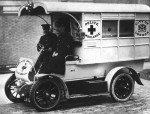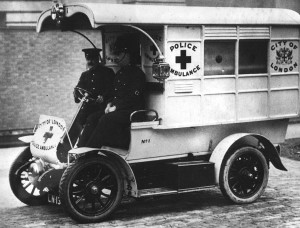
 Ambulance automobile pour Londres et sa banlieue, 1913, Agence Rol, GallicaThe 20th century oversaw the development of emergency medicine as a new public health norm.
Ambulance automobile pour Londres et sa banlieue, 1913, Agence Rol, GallicaThe 20th century oversaw the development of emergency medicine as a new public health norm.
Rated as perceived or actual, medical or social, emergency is a medical category whose parameters were established in step with 20th century socio-political evolutions. In its most commonly accepted sense, an emergency is associated with the necessity of prompt action towards avoiding a person’s death or the severe degradation of their welfare. This notion, while elusive, remains subject to the technical and medical means available to society to handle casualties.
Historically, medical emergencies correlated essentially with epidemics; the steps taken to keep contagious sufferers at bay connote with the will to protect a maximum of human lives in line with group preservation policies. However, first aid as it is currently understood, along with the conditions which make a discourse on emergency possible, rely on the knowledge of biological life processes. It is only in the 18th century that the anthropological conception of death shifted as a result of medical observations yielded by the recovered bodies of drowned people. Death, no longer perceived as a moment, progressively became a process which it was possible to combat. The escalating likelihood of accidents in the context of industrialisation politicised the question of medical emergency and drove to the authorities’ involvement in its management, notably by means of town constabularies responsible for attending to casualties.
Today, medical emergency is apprehended pretty much through the experience of warfare and the triage and anticipation culture typical of its military antecedents. Doctors own that emergency medicine was born on the Napoleonic wars’ battlefields when surgeon Larrey set up an ambulance corps to evacuate the wounded to the rear. The need for the casualties’ expeditious care towards maximising their chances of survival was verified in the 20th century’s world wars. The nations gradually developed medical institutions apt at mending the wounded with a view to their prompt return to the productive category. Wars are a crucible for the evolution of first response technologies and medical thought. The notion of shock devised by war surgeons refers to an organism’s responses to the combined aggressions degrading the wounded’s condition and leading to their death if not rapidly addressed. This overall conception of casualty care led to the rise of anaesthesia and reanimation, disciplines that drive the emergency discourse. Even if, in the United States, emergency medicine was largely shaped by the Vietnam experience, the medical gains did not necessarily transfer to peace time civilian America.
Medical and social evolutions also contributed to asserting emergency care as a major stake in public health. Even as infectious diseases were better cared for, the fight against accidental death gradually came to represent the health authorities’ priority in industrialised societies which, starting in the 50s, registered an unprecedented growth in road accidents. In this context, the debate around first aid management involved the full range of health care professionals, first aid associations, the police and firefighting forces who collaborated – or at time competed with each other to rescue threatened human lives. The role of transportation and telecommunication proved key to the devising of emergency care; as from the 60s, the motorcar and the telephone became the prerequisite tools for the management of medical emergencies.
The setting up of emergency departments in hospitals, of control rooms (such as SAMU, France’s Emergency medical services) and first aid training improved the emergency care offer and embedded them in the healthcare landscape.
Whereupon a loose understanding of emergency emerged: with the dwindling of out-of-hours-services in a context of rising precarity and expectations of immediacy, the emergency services are called upon to treat a broad diversity of cases which have brought into light the parlous state of public hospitals. Emergency medicine has come to expose the dislocation between biological time, social time and institutional time.
To follow on the dictionnary :Telemedicine
Références :
Guillaume Lachenal, Céline Lefève et Vinh-Kim Nguyen (dir.), La médecine du tri : histoire, éthique, anthropologie, Paris, Presses Universitaires de France, 2014.
Jean Peneff, Les malades des urgences : une forme de consommation médicale, Paris, Éditions Métailié, 2000.
To quote this paper : Charles-Antoine Wanecq, "Emergency Medicine" in Hervé Guillemain (ed.), DicoPolHiS, Le Mans Université, 2021.